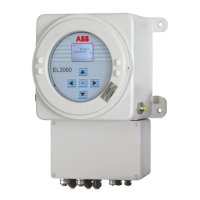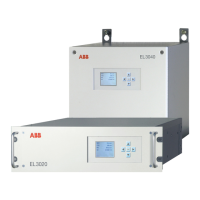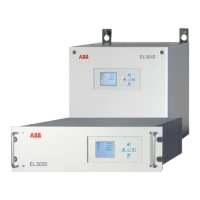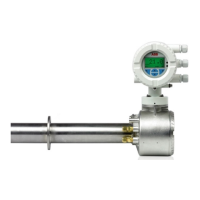EL3000 CONTINUOUS GAS ANALYZERS | CI/EL3000-EN REV. C 105
Checking gas path leak tightness
When should gas paths be checked for leak tightness?
The leak tightness of the sample gas path should be checked on
a regular basis.
We recommend that you check the leak tightness of the sample
gas path prior to commissioning at the installation site, as it
may have been affected during transport of the gas analyzer
(for example, due to high vibrations).
The leak tightness of the sample gas path must always be
checked after the sample gas path has been opened inside the
gas analyzer.
Requisite Material
• Pressure gauge
• Hose, length approx. 1 m
• T-piece with stop cock
• Air or nitrogen
Explosion hazard
Explosion hazard due to mixing of air and flammable sample
gas residues in the sample gas path.
• If the leak tightness test is to be carried out with air and
the sample gas or test gas is flammable, the sample gas
path must be rinsed with nitrogen beforehand!
• Otherwise the leak tightness test can be performed with
Check leak tightness
1. Close off the sample gas output so it is gas-tight.
2. Connect the T-piece with stop cock to the sample gas inlet
with the hose.
3. Connect the free end of the T-piece to the pressure gauge.
4. Blow air or nitrogen through the stop cock until the sample
gas feed path is under a gauge pressure of approx. 50 hPa.
Maximum gauge pressure = 150 hPa.
5. Close the shut-off valve. The pressure should not change
measurably in 3 minutes. A sharp pressure drop is an
indication of a leak inside the sample gas path.
6. Repeat steps 1 to 5 for all sample gas paths in the gas
analyzer.
Dichtigkeit d
Check the integrity of combustion gas
path
Combustion gas line
The seal integrity of the combustion gas feed line must be
regularly checked in accordance with the two following
instructions, depending on whether the combustion gas is
offered from a bottle or a central supply.
Combustion gas supply from a cylinder
1. Switch off the gas analyzer power supply. Ensure that the
shut-off valve in the combustion gas supply line is open.
2. Set the combustion gas pressure at 1.1 x the normal pressure
of the combustion gas, i.e. at approx. 1.4 bar.
3. Mark bottle pressure display on the high-pressure
manometer.
4. Close the valve of the combustion gas bottle.
5. Observe the display on the high-pressure manometer – it
should not change measurably in 10 minutes.
• A measurable change in the display is an indication of a
leak in the combustion gas path between the bottle
pressure reducer and the combustion gas inlet valve of
the gas analyzer.
In this case the following measures are to be taken:
– Check the combustion gas line between the bottle
and gas analyzer with a leak detection spray. A leak in
this area must be remedied and another leak test
must be performed before the gas analyzer is put into
operation again.
– If no leak is found, that means the gas analyzer
combustion gas inlet valve is leaky.
Explosion hazard
Explosion hazard if there is a leak in the combustion gas inlet
valve.
If a leak is detected at the combustion gas inlet valve:
• Disconnect the combustion gas supply.
• Do not restart the gas analyzer.
• Have the combustion gas valve replaced by the ABB
6. After conclusion of the seal integrity test, set the combustion
gas pressure to normal pressure again, i.e. 1.2 bar.
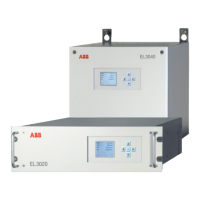
